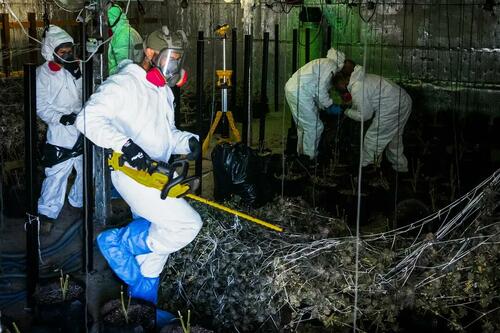Toxic Homes For Sale: How California's Illegal Marijuana Industry Ruins Houses
Authored by Beige Luciano-Adams via The Epoch Times (emphasis ours),
LOS ANGELES—On a recent summer morning, a caravan of unmarked state police vehicles and white hazmat trucks crept past strip malls and wide intersections, making its way toward a pair of modest homes in a remote suburb north of Los Angeles.
A command came from the officers in the front of the black-and-white: “Seat belts off—in case we start taking fire.”

But there was no shootout. Just a tense half hour as a phalanx of two dozen state police—agents from the Department of Cannabis Control (DCC)—kept snipers trained on the house, waiting for the second of two suspects to emerge.
When she finally did, petite and barefoot in a black dress, the effect was mercifully anticlimactic.
Illegal cannabis cultivation operations, or “grows,” are a multi-billion-dollar-a-year industry in California, dominated by a mix of transnational criminal organizations that authorities believe are symbiotic, if adversarial.
When agents serve a warrant, they often find human trafficking victims, automatic weapons, booby traps and, increasingly, banned toxic pesticides smuggled from China.
This particular raid, in Lancaster, netted around 1,020 plants—a modest haul compared with the herculean grows that have become common across California’s booming black market.
But such mild suburban tableaus belie a sleeping, sinister threat.
“What we have right now is organized criminal enterprises literally destroying the city building by building as they modify them for illegal cultivation,” Mike Katz, a Lancaster code enforcement officer who heads the city’s cannabis unit, told The Epoch Times.
“They’re endangering the families who will occupy those buildings in the future, they are lowering the value of neighboring properties and dragging the whole community down,” he said.
‘Super Toxic’
Buildings contaminated by illegal grows are dangerous because the harsh pesticides growers use permeate every surface—ceilings, walls, floors, vents and drywall.
Toxic black mold blooms in the 75 percent humidity needed to grow marijuana. The massive amounts of water and electricity required to sustain an operation can result in structural damage to vents and sunken floors, overloaded transformers and corroded wiring just itching for a fire.
Katz, whom the city’s chief of police refers to as the department’s “Swiss Army knife,” has been a firefighter, reserve police officer, and now, an unarmed code enforcement official. He approaches the job with a certain zeal, devouring scientific studies and how-to books on cultivation, and generally making it his mission to stop grow houses from slipping through the cracks.
Owners can often get away with making cosmetic fixes—“candy coating,” as one inspector puts it—if local governments don’t intervene before they start concealing the damage.

Working and middle-class families migrate to bedroom communities like Lancaster, where you can still find a single-family home with a backyard for around $500,000—about half the median price in Los Angeles, according to Redfin. You may find one for even less if a grower has been busted and is offloading at a discount.
The injustice of it rankles Katz. He imagines families struggling to buy a home, and their toddlers probing surfaces tainted with insecticides—potent carcinogens, endocrine disruptors, nerve agents and others no one even knows how to identify.
“They are super toxic, but very effective,” he said. “One we just learned of last week has a 14-year half-life. We did a search warrant back in January and didn’t get test results until this week. I’m having to tell all the detectives and everyone involved that we were exposed to these chemicals.”
Low-cost housing also attracts sophisticated criminal enterprises looking for ways to launder money and turn a profit. Often, illegal growers can do that after just one harvest. Typically, an operation can turn four to six harvests a year.
Wholesale value for the plants seized in the modest raid we accompanied—they were days away from a second harvest—is more than $540,000.
To avoid detection and stay a step ahead of authorities, growers are continually adapting.
“There are probably a lot more growing indoors that we don’t know about,” Jennifer Morris, a code enforcement officer with Riverside County and former head of its cannabis unit, told The Epoch Times. “But they’re pretty good at keeping themselves looking very nondescript.”
From the outside, the houses look normal, and it typically takes a fire, robbery, or neighbors reporting electrical theft to tip off law or code enforcement, Morris said. Growers also build walls to conceal grow rooms, and sometimes install a resident worker or a dog to give the appearance of normality.
Because the entire industry is clandestine, no one can accurately estimate the extent of the problem. Many communities might not even be aware it’s happening.
“I’ve talked to cities where they say, ‘We don’t have a problem,’” said David Welch, an attorney who contracts as a special counsel with cities in Los Angeles County that want “a more aggressive” approach to narcotics enforcement. “Then law enforcement will hit a grow in that city.”

Where there is one, there are likely more. But perpetrators are opportunistic, itinerant.
“We have seen the same owners of properties in different counties that have had illegal cultivation on them,” Morris said.
Wilson Linares, who leads the Department of Cannabis Control’s Los Angeles County law enforcement unit, said it’s hard to pinpoint which players are tied to which territories. “They’re just everywhere. It doesn’t really stay in that area, they just go wherever they can master operations.”
Growers, he said, “do a good job of layering their operation. I don’t think they even know they’re working for the same organization sometimes.”
That makes it difficult to go after the few bigger fish, to which, some insiders say, all these operations are ultimately “funneling up.”
Those caught at the grows are inevitably low-level employees, if not forced labor, and are typically interviewed and released. Illegal cultivation—anything more than six plants per person, whether it’s 10 or 10,000—is a misdemeanor in California.
“Sometimes our investigations do a good job at digging to make sure we’re eradicating the problem,” Linares said. “But sometimes they cut losses and move on and go somewhere else. We have to follow and chase them. It takes a lot of effort and time to conduct these investigations.”
Like meth houses of decades past, there are residential grows too damaged to flip.
But it’s the moderate ones, the ones that are at risk of selling at a discount to families, that keep Katz up at night.
While they can’t prevent the sale, or in many cases, habitation, building inspectors and code enforcement officers use “red tagging” and other methods to compel compliance—like creating liens to cloud the title, or disconnecting utilities. And in some cases, those costs and headaches transfer to new owners.
California law gives local government broad authority to abate “public nuisances”—which include dangerous and contaminated buildings, Katz said. But enforcing compliance can often depend on a municipality’s ability to pay for things like civil lawsuits.
If public safety officials don’t discover a grow before property owners start hiding the damage, it’s often too late.
“There is no roadmap,” Katz said. “These sociopaths are buying and selling these houses.”

‘I Didn’t Know Anything’
There were signs. Two dozen large bags of what Virginia Aceres thought was ordinary grass fertilizer and canisters of chemicals bearing designs of spiders and worms that the previous owner left behind. He offered to pay her $500 to get rid of them.
In two months, a $10,000 electricity bill.
Aceres said she moved from Los Angeles to the Antelope Valley because she didn’t want her kids hanging out with people who use drugs. She nabbed a five-bedroom house for $535,000, $15,000 below asking. “It’s super big—we thought, oh wow, this is perfect.”
But she found out after moving in that it had been used by the previous owners to grow weed.
“Every afternoon the upstairs smells of marijuana and it gives me a raging headache,” she told The Epoch Times. When a city inspector came by and pointed out a convertor wired to steal electricity and stains on the bathroom ceilings from burned chemicals, she said, “Now I understand.”
The five bedrooms were originally three, she discovered; the previous owner had added two and it was up to her to register the additions with the city.
When property owners obtain permits to modify buildings but don’t follow up to call for a final inspection of the work, this can tip off code enforcement and form part of the basis for a warrant. So too can electrical fires or electricity theft.
But Aceres said she bought her house without any compliance obligations that would arise from a pre-sale code enforcement; inspectors came after she moved in and pointed out the damage.
The fuses at Aceres’ house are constantly blowing, especially if electronics are running at the same time, and electricians tell her she has to completely redo the wiring.
“My daughter relies on a machine to help her breathe,” Aceres said, referring to a nebulizer that delivers oxygen and liquid steroids. “We had to buy a generator. She’s 9; she can’t ride a bike, can’t walk more than 20 minutes, can’t run. At night she has panic attacks, she comes to my door in pain, she can’t breathe, so I connect the machine and give her medicine.”
A neighbor warned her the previous owner had installed multiple, massive air conditioners and there were fires. People cruise by the house. Someone showed up looking to collect on a debt. The IRS, the police and city inspectors have all visited.
“For all this, I’d like to move—because they’re going to confuse us and they’re going to think that we sell drugs or have something to do with all that. But we haven’t been able to sell the house because of all these problems,” she said. “If a buyer asks questions we’re obligated to tell them the truth.”
Read the rest here...


